
Villager Caroline is seen in a withered maize crops field in Kidemu sub-location in Kilifi County, Kenya, March 23, 2022.
Scattered on the five-acre farm in Bandari village, Kidemu sub-location in Kenya's coastal Kilifi County, were withered maize crops.
Adam Ndamunga, an officer with Kenya National Drought Management Authority (NDMA) in Kilifi, said the drought situation in the region started in August 2021 and has been progressing due to inadequate rains.
The United Nations relief agency said the Horn of Africa is experiencing one of its worst droughts in recent history, with more than 13 million people severely food insecure in Ethiopia, Kenya and Somalia. (Xinhua/Dong Jianghui)
NAIROBI, March 29 (Xinhua) -- Scattered on the five-acre farm in Bandari village, Kidemu sub-location in Kenya's coastal Kilifi County, were withered maize crops.
"I planted the crops as soon as the rains started, but they stopped soon after. The crop has failed completely. We are facing hunger, I don't have anything to eat," Zawadi Msafiri, the farm owner told Xinhua at her farm recently.
"I had 40 cows, 32 of them died because of drought. I also planted maize and the crop failed. We are barely surviving. I don't know what my children will eat next or if I will be able to take them to school," said 45-year-old Caroline in Kilifi, adding her cows were the main source of income for her family.
Caroline observed that getting food has become harder, with her family mainly relying on relief food. "Most of the time we only drink porridge," she said.
For Eliud Karisa, another Kilifi resident, he lost three of his cows and several goats to the ongoing drought.
"I now have only four goats. There is neither food nor water. I can't even feed my children or take them to school," he said.
If animal prices were good, he observed, he would sell the goats to cater to his needs but traders are buying at very low prices. "I can't sell, I better feed them some of the rations we receive hoping that it would rain and the price would increase once again," he said.
Adam Ndamunga, an officer with Kenya National Drought Management Authority (NDMA) in Kilifi, said the drought situation in the region started in August 2021 and has been progressing due to inadequate rains.
"We have lost some 9,500 animals due to lack of pasture and water. People require relief food. The situation is getting worse, if it does not rain we might experience severe drought," he said.
Ndamunga noted up to 219,000 people in the area are currently facing acute hunger, up from 145,000 people last year.
According to NDMA, the latest crisis has been fomented by failed October to December 2021 short rains, leading to poor crop production and low pasture and water resources for livestock. Sunny and dry weather conditions prevailed over most parts of the country during February.
"We are not receiving adequate rains to plant crops like maize, which take seven months to mature. For the current forecast for Kilifi, we might get around 330mm of rainfall, down from 550mm in the past. We are, therefore, asking farmers to plant drought-resistant and early-maturing crops," said Ndamunga.
About 3.1 million people in Kenya were in need of urgent food assistance and at least 1.5 million livestock had died, according to Short Rains Food and Nutrition Security assessment released by NDMA in February this year.
To alleviate the hunger crisis, the Kenyan government has been distributing relief food, building water pans, trucking water for livestock and sending cash to vulnerable families.
The United Nations relief agency said the Horn of Africa is experiencing one of its worst droughts in recent history, with more than 13 million people severely food insecure in Ethiopia, Kenya and Somalia.
"This drought risks becoming one of the worst climate-induced emergencies seen in recent history in the Horn of Africa," the UN Office for the Coordination of Humanitarian Affairs (OCHA) warned in its latest humanitarian update on March 23.
It said families are taking desperate measures to survive, with thousands leaving their homes in search of food, water and pasture.
According to the OCHA, the October-December 2020, March-May 2021 and October-December 2021 seasons were all marred by below-average rainfall, leaving large swathes of Somalia, southern and south-eastern Ethiopia, and northern and eastern Kenya facing exceptional drought.
"Latest forecasts indicate that the March to May rainy season is likely to be average to below-average. If this season fails, it would result in an unprecedented (in the last 40 years) sequence of four below-normal rainfall seasons and major increases in food insecurity would be expected," OCHA warned.
It said more action is urgently required to avert large-scale loss of life in the Horn of Africa in the period ahead and to enable communities to return to self-reliance and build resilience against future shocks.
According to OCHA, humanitarian partners have appealed for more than 4.4 billion U.S. dollars to provide life-saving assistance and protection to about 29.1 million people in Ethiopia, Kenya and Somalia in 2022.
"We urgently call on donors to fund these appeals so that we can immediately respond to the life-threatening needs across the Horn of Africa. " OCHA said. ■
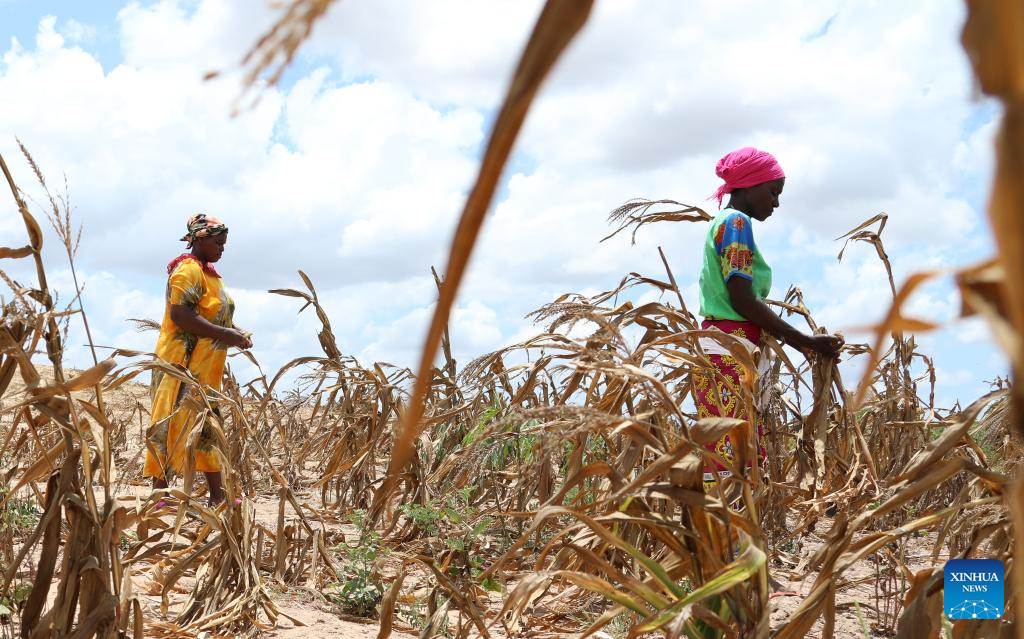
Villagers Zawadi Msafiri (R) and Caroline are seen in a withered maize crop field in Kidemu sub-location in Kilifi County, Kenya, March 23, 2022.
Scattered on the five-acre farm in Bandari village, Kidemu sub-location in Kenya's coastal Kilifi County, were withered maize crops.
Adam Ndamunga, an officer with Kenya National Drought Management Authority (NDMA) in Kilifi, said the drought situation in the region started in August 2021 and has been progressing due to inadequate rains.
The United Nations relief agency said the Horn of Africa is experiencing one of its worst droughts in recent history, with more than 13 million people severely food insecure in Ethiopia, Kenya and Somalia. (Xinhua/Dong Jianghui)
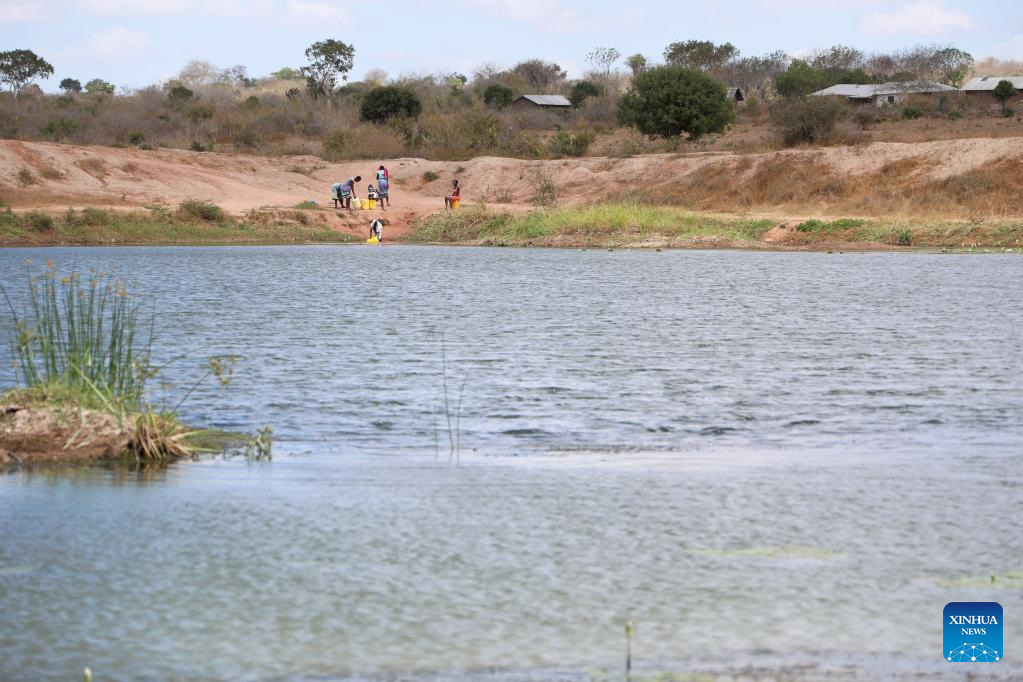
Villagers fetch water in Kidemu sub-location in Kilifi County, Kenya, March 23, 2022.
Scattered on the five-acre farm in Bandari village, Kidemu sub-location in Kenya's coastal Kilifi County, were withered maize crops.
Adam Ndamunga, an officer with Kenya National Drought Management Authority (NDMA) in Kilifi, said the drought situation in the region started in August 2021 and has been progressing due to inadequate rains.
The United Nations relief agency said the Horn of Africa is experiencing one of its worst droughts in recent history, with more than 13 million people severely food insecure in Ethiopia, Kenya and Somalia. (Xinhua/Dong Jianghui)

Villager Eliud Karisa shows the remains of his dead cows in Kidemu sub-location in Kilifi County, Kenya, March 23, 2022.
Scattered on the five-acre farm in Bandari village, Kidemu sub-location in Kenya's coastal Kilifi County, were withered maize crops.
Adam Ndamunga, an officer with Kenya National Drought Management Authority (NDMA) in Kilifi, said the drought situation in the region started in August 2021 and has been progressing due to inadequate rains.
The United Nations relief agency said the Horn of Africa is experiencing one of its worst droughts in recent history, with more than 13 million people severely food insecure in Ethiopia, Kenya and Somalia. (Xinhua/Dong Jianghui)

Villager Zawadi Msafiri is seen in a withered maize crop field in Kidemu sub-location in Kilifi County, Kenya, March 23, 2022.
Scattered on the five-acre farm in Bandari village, Kidemu sub-location in Kenya's coastal Kilifi County, were withered maize crops.
Adam Ndamunga, an officer with Kenya National Drought Management Authority (NDMA) in Kilifi, said the drought situation in the region started in August 2021 and has been progressing due to inadequate rains.
The United Nations relief agency said the Horn of Africa is experiencing one of its worst droughts in recent history, with more than 13 million people severely food insecure in Ethiopia, Kenya and Somalia. (Xinhua/Dong Jianghui)

The only eight remaining cows in Caroline's home are seen in Kidemu sub-location in Kilifi County, Kenya, March 23, 2022.
Scattered on the five-acre farm in Bandari village, Kidemu sub-location in Kenya's coastal Kilifi County, were withered maize crops.
Adam Ndamunga, an officer with Kenya National Drought Management Authority (NDMA) in Kilifi, said the drought situation in the region started in August 2021 and has been progressing due to inadequate rains.
The United Nations relief agency said the Horn of Africa is experiencing one of its worst droughts in recent history, with more than 13 million people severely food insecure in Ethiopia, Kenya and Somalia. (Xinhua/Dong Jianghui)
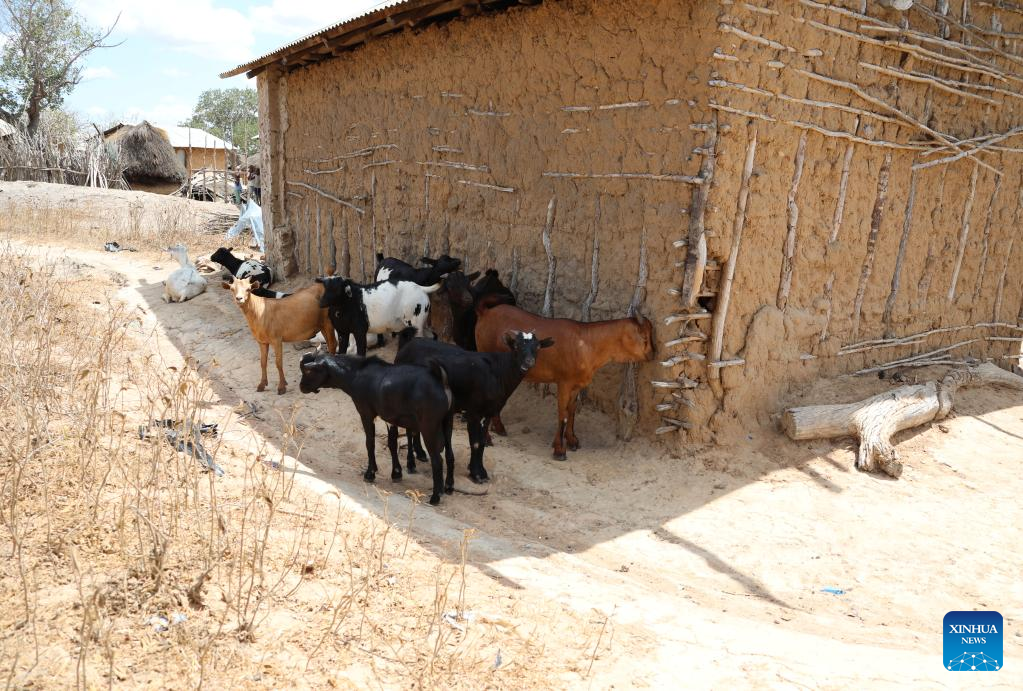
Livestock keep cool in the shade of a roof in Kidemu sub-location in Kilifi County, Kenya, March 23, 2022.
Scattered on the five-acre farm in Bandari village, Kidemu sub-location in Kenya's coastal Kilifi County, were withered maize crops.
Adam Ndamunga, an officer with Kenya National Drought Management Authority (NDMA) in Kilifi, said the drought situation in the region started in August 2021 and has been progressing due to inadequate rains.
The United Nations relief agency said the Horn of Africa is experiencing one of its worst droughts in recent history, with more than 13 million people severely food insecure in Ethiopia, Kenya and Somalia. (Xinhua/Dong Jianghui)
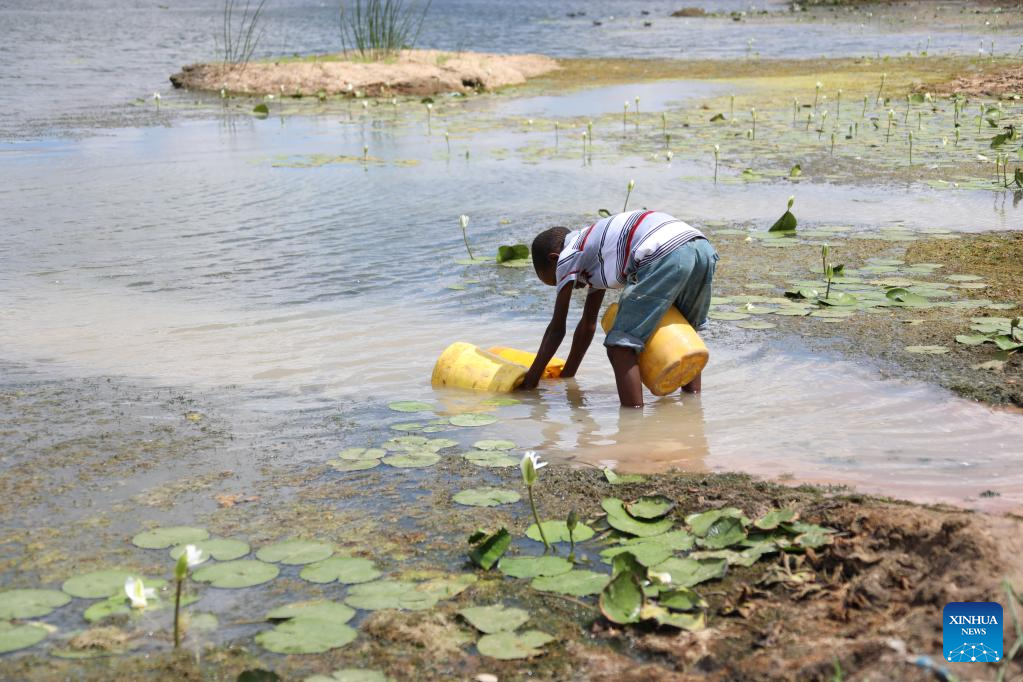
A boy fetches water in Kidemu sub-location in Kilifi County, Kenya, March 23, 2022.
Scattered on the five-acre farm in Bandari village, Kidemu sub-location in Kenya's coastal Kilifi County, were withered maize crops.
Adam Ndamunga, an officer with Kenya National Drought Management Authority (NDMA) in Kilifi, said the drought situation in the region started in August 2021 and has been progressing due to inadequate rains.
The United Nations relief agency said the Horn of Africa is experiencing one of its worst droughts in recent history, with more than 13 million people severely food insecure in Ethiopia, Kenya and Somalia. (Xinhua/Dong Jianghui)
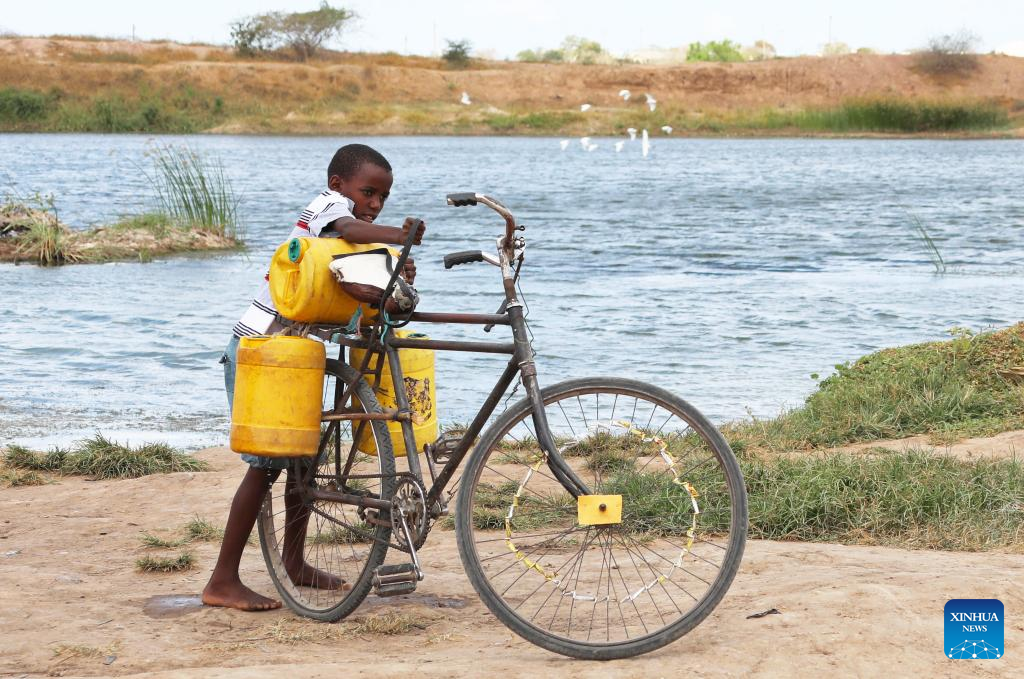
A boy loads a bucket of water onto a bicycle in Kidemu sub-location in Kilifi County, Kenya, March 23, 2022.
Scattered on the five-acre farm in Bandari village, Kidemu sub-location in Kenya's coastal Kilifi County, were withered maize crops.
Adam Ndamunga, an officer with Kenya National Drought Management Authority (NDMA) in Kilifi, said the drought situation in the region started in August 2021 and has been progressing due to inadequate rains.
The United Nations relief agency said the Horn of Africa is experiencing one of its worst droughts in recent history, with more than 13 million people severely food insecure in Ethiopia, Kenya and Somalia. (Xinhua/Dong Jianghui)

A water bank is pictured in Kidemu sub-location in Kilifi County, Kenya, March 23, 2022.
Scattered on the five-acre farm in Bandari village, Kidemu sub-location in Kenya's coastal Kilifi County, were withered maize crops.
Adam Ndamunga, an officer with Kenya National Drought Management Authority (NDMA) in Kilifi, said the drought situation in the region started in August 2021 and has been progressing due to inadequate rains.
The United Nations relief agency said the Horn of Africa is experiencing one of its worst droughts in recent history, with more than 13 million people severely food insecure in Ethiopia, Kenya and Somalia. (Xinhua/Dong Jianghui)
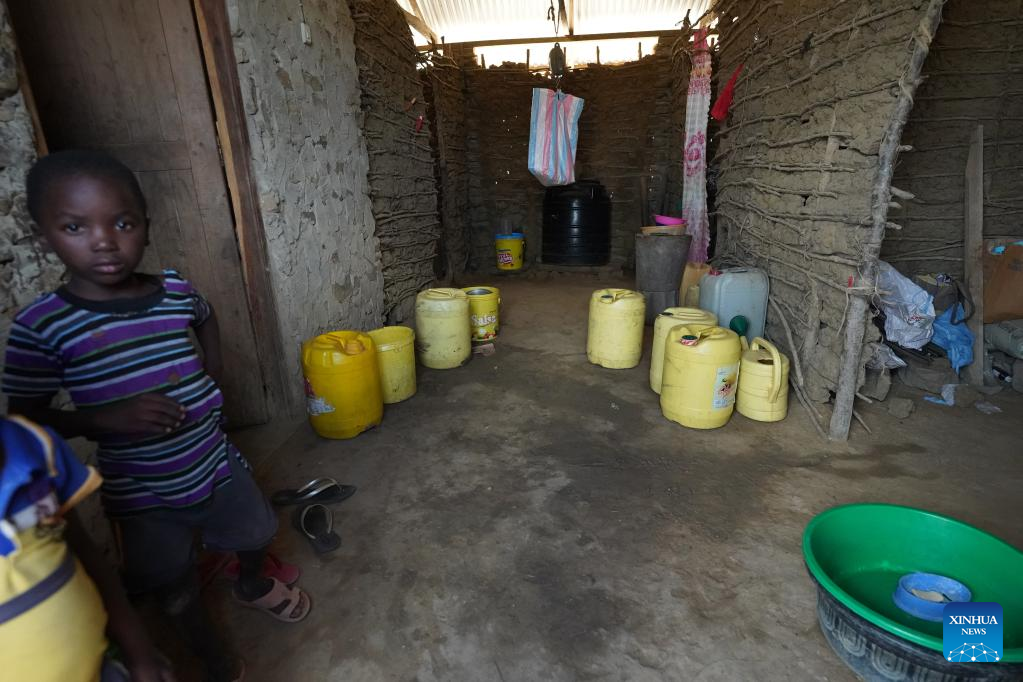
Buckets of water are seen in Caroline's house in Kidemu sub-location in Kilifi County, Kenya, March 23, 2022.
Scattered on the five-acre farm in Bandari village, Kidemu sub-location in Kenya's coastal Kilifi County, were withered maize crops.
Adam Ndamunga, an officer with Kenya National Drought Management Authority (NDMA) in Kilifi, said the drought situation in the region started in August 2021 and has been progressing due to inadequate rains.
The United Nations relief agency said the Horn of Africa is experiencing one of its worst droughts in recent history, with more than 13 million people severely food insecure in Ethiopia, Kenya and Somalia. (Xinhua/Dong Jianghui)
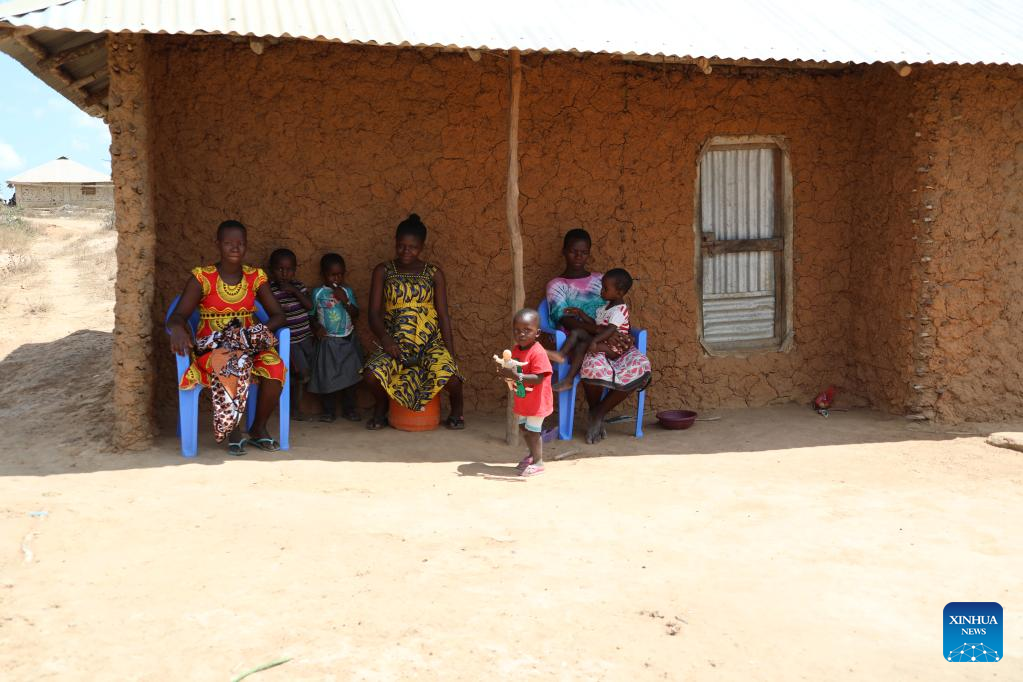
Villagers sit in the shade of a roof in Kidemu sub-location in Kilifi County, Kenya, March 23, 2022.
Scattered on the five-acre farm in Bandari village, Kidemu sub-location in Kenya's coastal Kilifi County, were withered maize crops.
Adam Ndamunga, an officer with Kenya National Drought Management Authority (NDMA) in Kilifi, said the drought situation in the region started in August 2021 and has been progressing due to inadequate rains.
The United Nations relief agency said the Horn of Africa is experiencing one of its worst droughts in recent history, with more than 13 million people severely food insecure in Ethiopia, Kenya and Somalia. (Xinhua/Dong Jianghui)
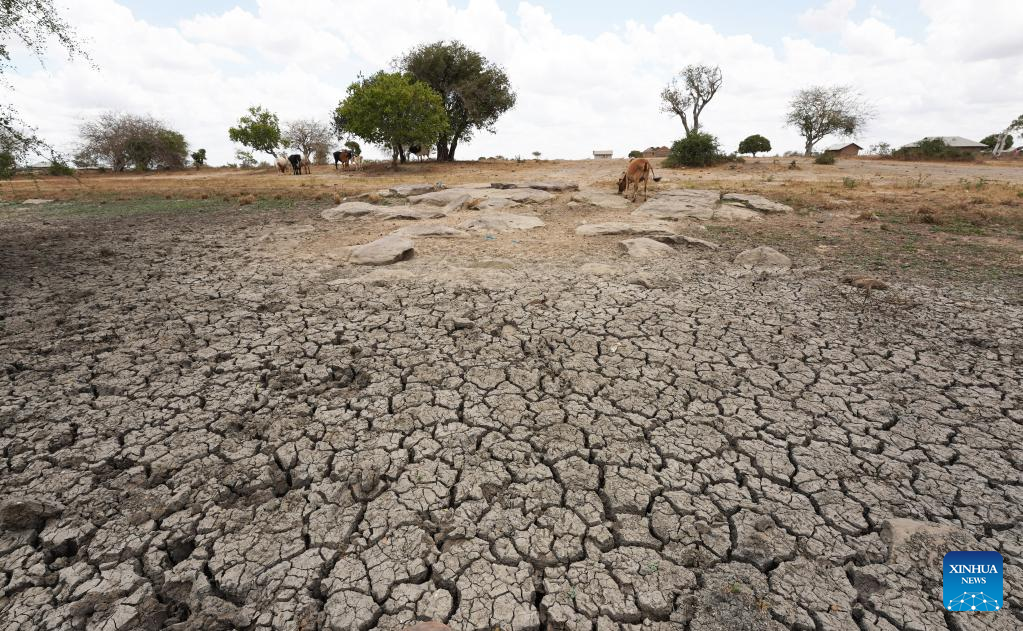
Livestock are seen on the drought field in Kidemu sub-location in Kilifi County, Kenya, March 23, 2022.
Scattered on the five-acre farm in Bandari village, Kidemu sub-location in Kenya's coastal Kilifi County, were withered maize crops.
Adam Ndamunga, an officer with Kenya National Drought Management Authority (NDMA) in Kilifi, said the drought situation in the region started in August 2021 and has been progressing due to inadequate rains.
The United Nations relief agency said the Horn of Africa is experiencing one of its worst droughts in recent history, with more than 13 million people severely food insecure in Ethiopia, Kenya and Somalia. (Xinhua/Dong Jianghui)
